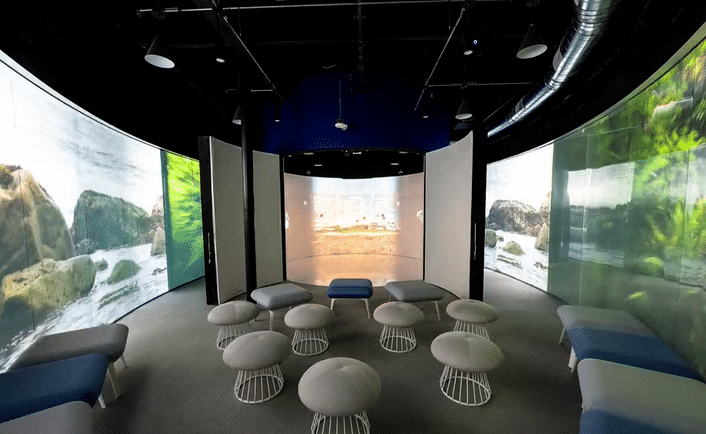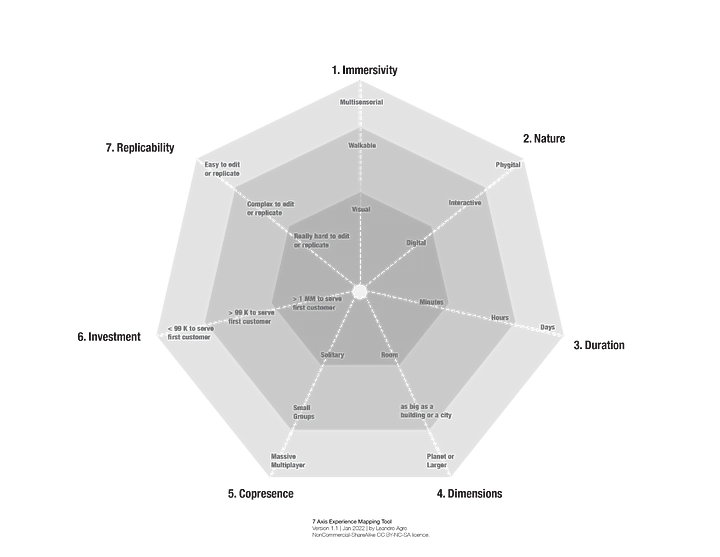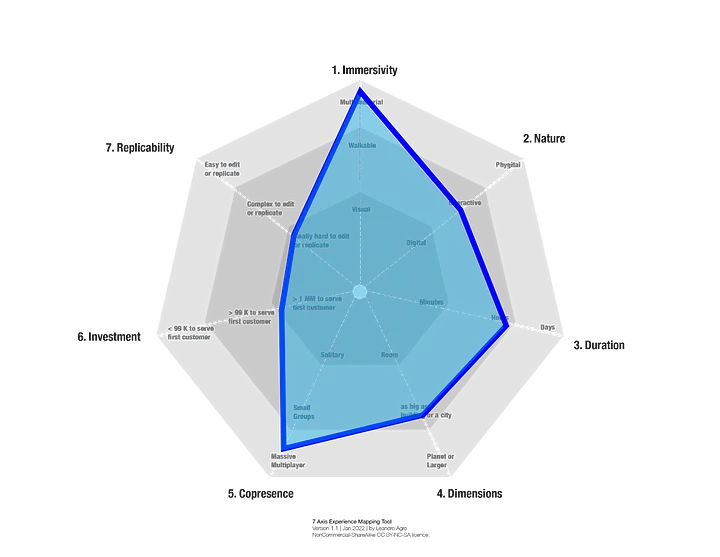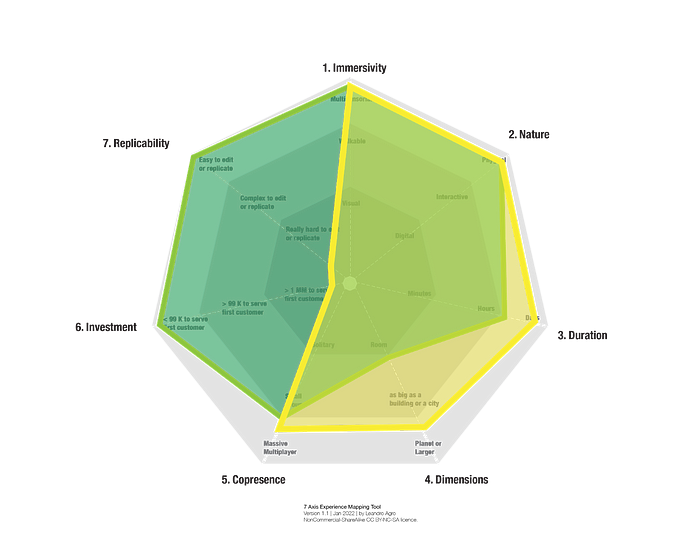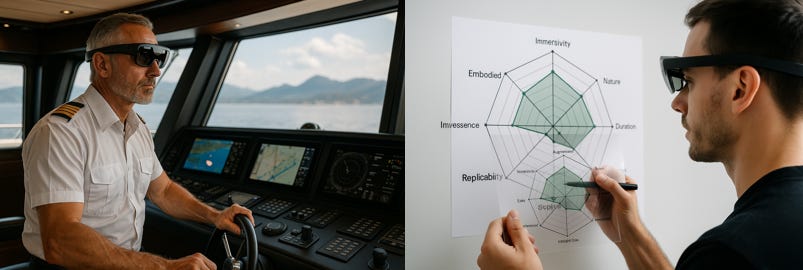The 7 Axis Experience Mapping Tool (7AEMT) | Re-imagined in 2025
A simple and powerful canvas to evaluate, design, and communicate immersive experiences of any kind. Now updated with AI.
The Covid-19 pandemic redefined how we live, work, and interact with spaces. Homes, offices, schools, museums, theaters, stores—no environment was left untouched. Designers suddenly faced new challenges and scenarios. Among them: creating spaces where remote and physical participants could feel equally included. A challenge we defined as Hybrid Inclusivity. (find some projects here)
Hybrid Inclusivity isn’t about plugging in a webcam. It means giving remote participants a real presence: life-sized, lag-free, glitch-free, perceptually equal. It requires spatial dignity, not just technical connection.
But how do we design for that?
We need imagination—and structure. That's why I created the 7 Axis Experience Mapping Tool (7AEMT) during my time as Director of Exponential Technologies at NTT Disruption in San Francisco, CA. I was part of a team developing a product to revolutionize the integration of physical and digital spaces. There was a strong need to identify possible scenarios where new implementations of emerging technologies could improve people's lives. The tool became a shared language—an activator of visions.
Why a Radar?
The 7AEMT is not a scorecard. It doesn’t quantify or rank. It visualizes. Like any radar, it helps you detect what's otherwise invisible.
Each axis defines a critical aspect of an immersive experience. By plotting them, we can see its "shape," opening up conversations and comparisons. We can map a museum visit, a video game, a business meeting, or a theme park on the same canvas. That common language makes strategy and design actionable.
Here are the original 7 axes:
1. Immersivity
Visual → Walkable → Multisensory
From watching a video to walking in a VR room to interacting via gesture, touch, and sound. The more senses involved, the deeper the immersion.
2. Nature
Digital-only → Digital Interactive → Phygital
Does the experience live purely online? Or does it mix digital with physical environments, as in augmented exhibits or smart spaces?
3. Duration
Minutes → Hours → Days
Time affects expectations. A 5-minute experience needs different design logic than a 3-day immersive festival.
4. Dimensions / Size
Room → Building/City → Planet/Universe
How big is the stage? A single room, an entire building, a multiplayer planetary scale? Digital spaces extend this axis dramatically.
5. Copresence
Solitary → Small Group → Massive Multiplayer
Experiences can be personal or collective. This axis covers both physical and hybrid presence.
6. Investment (to serve first user)
> 1M → > 99K → < 99K
How much does it cost to make the first instance usable? This isn't about pricing. It's about viability and barriers to entry.
7. Replicability
Hard → Complex → Easy
Can you duplicate it? Some experiences are unique or costly to replicate. Others are near plug-and-play.
Using the Radar
With 7AEMT, we can:
analyze existing experiences
design future experiences
align multidisciplinary teams
make abstract visions concrete
Let’s look at two examples:
Physical Exhibit (e.g. Van Gogh immersive in SF)
Multisensory, Phygital, Hours long
Takes place in a building
Hosts small groups
Medium investment, semi-replicable
Virtual Exhibit (e.g. Star Wars in Oculus)
Visual-to-Multisensory, Digital Interactive
Shorter duration (30 minutes)
Room scale, Solo or Small Group
Low cost, high replicability
Plotting both reveals their strengths and limits—and suggests opportunities for hybrid formats.
Leveraging 7AEMT to imagine desirable futures
Now we will use our radar in reverse, that is, not to analyze an existing experience, but to imagine the ideal experience for a business context.
I could refer to real cases we were working on and take it as a credible example. According to these preliminary applications, the ideal experience for a business context should:
Be multi-sensory (high immersivity).
Integrate physical space with digital content.
Be able to last hours (not minutes, but not days either).
Is adequate to fill a room or a conference room or innovation center. Usually, it doesn’t need to be any larger than that.
Be absolutely capable of accommodating hybrid groups, supporting co-presence and collaboration.
Cost as little as possible.
Be easily editable and repeatable.
Plotting these requirements on our radar, we get the following shape:
As you can see by comparing this chart to the forms obtained by analyzing the museum exhibit and the virtual exhibit with Oculus, our business experience covers areas that other experiences do not.
Below, two more charts depict a video game and an amusement park. I’ve overlaid them on top of our business experience so you can see what different requirements are at play.
Videogame / Living Room TV
This is a generic exhibition mapping. Example: No Man Sky for Playstation
Amusement Park
This is a generic exhibition mapping. Example: Disney Star Wars Galaxy Edge.
This allows us to make our needs visible and trigger conversations that, iteration after iteration, will allow the project to become more and more concrete: from an potential future to reality.
This example illustrates very well the usefulness of 7AEMT in the design process. That’s what the radar is for: it’s a Design Thinking visual tool to intercept desirable futures.
In 1992, in a memorable book (Computer as Theatre) Brenda Laurel presented a new theory of human-computer interaction. Building on Aristotle’s analysis of the form and structure of drama, Laurel showed how similar principles can help us understand what people experience when interfacing with computers.
Brenda Laurel’s theatrical metaphors have greatly inspired our work.
With the design team, we conceived a digital device that surrounds and defines a physical space: just like a theater, this space surrounds people and allows interaction between them, sometimes magical: imagine a speaker talking to an audience surrounded by the presentation.
As the presentation progresses from one slide to another, the previous slides don’t disappear but go to occupy a space on the room’s walls, which are actually digital displays or projections. The presentation ideas are always available and, if someone wants to review one of the previous slides, all he has to do is walk along the walls and find the one he’s looking for.
When completed, the presentation can remain available to the public for some time. Attendees can review, share, and comment on it, almost as in a museum exhibition.
Unlike a traditional theater, this digitally enhanced space allows hybrid co-presence, i.e., people present in the physical office space can collaborate profitably with people who at that moment only have a virtual presence.
This makes training much more effective, pushes company culture in a digital direction, strengthens identity and increases sales. Commerce is the most accurate Darwinism.
2025: Time to get an Update
Since 2020, something has changed.
Not just in tech, but in design constraints and opportunities:
Generative AI now allows entire experiences to be created on demand.
Spatial computing extends environments beyond screens.
AI agents participate, not just assist.
Experiences replicate at near-zero marginal cost.
Physical AI merges sensors, robotics, and intelligence in space.
The original radar was solid, but it needs an upgrade.
Introducing: 7AEMT v2.0
The second version of the tool was born not in a lab, but in the field—through direct experience with deep tech startupswhere Physical AI is central: in smart factories, in Space, or aboard a dreamlike superyacht—fully reimagined as an augmented body.
We kept the structure. We evolved the axes. We added new thresholds to capture the post-AI, post-screen world.
New Dimensions:
Immersivity now includes: Embodied (with spatial, haptic, or physical feedback)
Nature extends to: Persistent Spatial (always-on environments)
Duration adds: Asynchronous / Continuous (AI-activated over time)
Scope now includes: Synthetic Universes (digital-only, multi-agent spaces)
Copresence includes: Hybrid Intelligent Groups (humans + AI co-presence)
Investment reflects: Near-zero marginal cost (generative experiences)
Replicability includes: Self-generated / AI-personalized instances
This version reflects a key shift: we are no longer just designing spaces.
We are designing systems that design themselves.
This opens the door to entirely new modes of interaction—beyond screens, beyond input devices.
We’re entering a new phase of experience design—one that is increasingly deviceless and ambient. Immersive experiences are no longer confined to VR headsets or installations. Spatial technologies, especially those brought to the forefront by Apple and other AR players, are moving the interface into the environment itself.
This changes everything.
AR glasses are becoming the silent companions of critical missions—extending cognition, enabling real-time access to information, and supporting decision-making in context. In this light, spatial computing is not just a new UI, it’s a co-pilot.
Take the example of a SuperYacht captain. He’s not just commanding a vessel. He’s a human symbiotically connected to a 110-meter, four-deck body. Every system, every decision, every situational awareness moment is amplified by technology—and now, potentially, by Physical AI agents.
How would you represent the captain’s augmented experience on the 7AEMT v2.0 radar? In such environments, the experience is no longer something you “use.” It’s something you live in, and co-evolve with. The radar must account for this paradigm.
Use It To:
Visualize the "shape" of your idea
Compare experiences across industries
Align tech, content, and design
Avoid over-engineering
Reveal trade-offs early
The canvas is open and available [here]
Use it in workshops, keynotes, co-creation sessions. Or just to check if your big idea has a coherent shape.
Closing Thought
Not all experiences are equal.
But all experiences have a shape.
Draw it—before someone else decides it for you.
7AEMT v2.0
Mapping the possible. Designing the desirable. Download the Canvas!
Curious about my work? Find me: leeander.com / Pasc3.com

